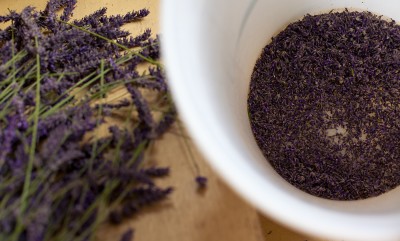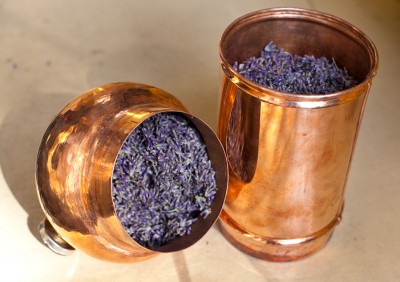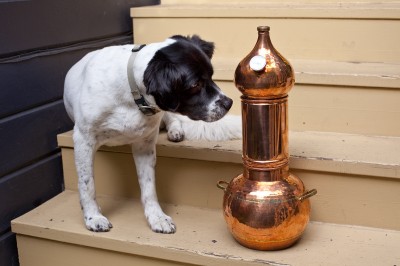We are Learning how to Distill Lavender
August 17, 2009
We are beginners. But keen to learn. This weekend, among a slew of interesting events, we distilled lavender in our house. Twice.
On Saturday, David wrapped up a water skiing trip to Sauvie Island with a stop at the Sauvie Island Lavender Farm. He bought two bunches of “Gros Bleu” lavender, a month or so past their true prime, but still flowery and fragrant. Here’s what we did:
- I spent some time “shelling the lavender.” I’d heard conflicting reports about distilling lavender’s essential oil: I’d heard “flowers/buds only” from one source and “flowers and stems” from another. I thought using flowers only would be a safer approach, and I was made nervous by the turpentine-wretched smell of our batch of Douglas-fir needle oil the previous week. I was striving for something less awful. Harvesting the flowers off of the stems turned out to be easy enough: grasp the stems, run hand over stem above bucket. Repeat a lot of times.
- I filled the stem-extender thing and the “onion” on the top of the still with lavender flowers. In this batch, as you can see, the flowers weren’t jammed in, just loosely piled.
- The traditional method to seal the seams between the pieces of the still is with a paste of rye flour and water. This dough-caulk heats with the alembic still itself and, as it bakes on, creates an air-tight seal between the elements. Clever. Medieval.
- Once the still was all piled onto itself, we hooked up circulating water to the condenser to keep the water cool. As the distillate condenses out, the coils heat the surrounding water, so it needs to be replaced periodically. Otherwise it will boil itself and stop serving its purpose of condensing. There are two spouts on the condenser for this purpose. Using my brain bits I determined that the spout on the bottom should be incoming water such that the hot water comes out of the upper spout. You know. Thermodynamics and common sense. David helped rig something up with PVC tubing and the sink. Finally, a smaller-diameter tube runs from a third output spout on the condenser into a collecting container. This is the spout that actually comes out of the condenser coil itself and is where the good stuff emerges.
- I turned on the heat and maintained the onion temperature at about 110˚C. Whether or not this is an ideal temperature or a completely stupid one is something I am not certain of. After a few hours, I had about 1.5 liters of distillate. From that, I was able to separate out about 3ml of pure oil using pipettes, patience, curiosity and a test tube.
The part of the distillate that isn’t oil-based is called a hydrosol and has merit of its own: it is quite fragrant and has its own set of uses. I bottled it in some wine bottles and corked it for later.
On Sunday, we returned to the lavender farm as part of a long motorcycle ride and bought double the number of bunches. Via both days’ batches, here is what I learned:
- Sunday’s batch came out totally different, in the oil sense. The oil came off of the second batch as dark as motor oil, and the first 1/3 or so of it (which I had the presence of mind to remove and keep separate from the rest of the oil) was nearly black and had a harsh edge of rubbery-stinky chemical. The rest of the oil from the second batch was a deep amber like maple syrup. Saturday’s batch was light gold, by contrast. I am not certain what caused this difference. In the second batch I threw in one bunch from a “silver” cultivar of lavender. The silver variant was much further post-bloom and had almost dry flowers. Perhaps that caused it. I also used overall much more plant material.
- Though I ended up with a nice vial full of oils from this weekend’s effort, I still denote a sharp edge to the scent. A bit of research helped me pinpoint why. I’d used “Gros Bleu”, which is lavendula x intermedia, that is, a hybrid of French lavender. From Wikipedia:
English lavender (Lavandula angustifolia) yields an essential oil with sweet overtones, and can be used in balms, salves, perfumes, cosmetics, and topical applications. Lavandin, Lavandula x intermedia (also known as French lavender), yields a similar essential oil, but with higher levels of terpenes including camphor, which add a sharper overtone to the fragrance. Spanish lavender, Lavandula stoechas is not used medicinally, but mainly for landscaping.
One Comment
Related Posts
- Mmmm, Fragrant: The dangers of the distillation season
March 9, 2010 - A Compendium, to Assuage Guilt
August 9, 2009 - Education: Apparently Mine is Weak
September 8, 2006 - The PDX Water Blog is Neat
January 4, 2007 - links for 2008-04-04
April 4, 2008







Hi, I found this really interesting and helpful….good pics too. Where did you get the still?